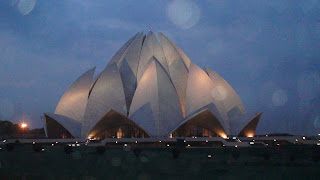




During the past few days, we visited several important Theravada Buddhism sites. One site in particular was a series of caves that included murals, tomb stupas and sculptures. Many of the Theravada Buddhism sites include sculptures of a reclining Buddha. Most often, these sculptures are enormous and hand carved of wood. The specific reclining Buddha sculptures that I have seen ranged from approximately 10 ft. to 50 ft.
Sigiriya is the site where the 5th century King of Sri Lanka had his palace. Although only the foundation remains today, the palace was constructed on top of a massive rock. We climbed approximately 2200 steps to get to the site. It was a pretty good workout. At the top we were able to appreciate a panorama of the lush tropical landscape. The rock is positioned in the middle of a 300-acre monastery. Half way up the mountain were a series of beautiful murals. I found these paintings to be especially intriguing because they were so different from all of the other artworks that I have seen in Sri Lanka and India. The murals included a group of women exclusively. In my opinion, in these paintings, the artist depicted a rise in the status of women. Although the women in the paintings are very sensual and idealized, they are not sexualized. Also, they are not performing any type of service or labor. Each woman in the murals has at least one reference to nature. I believe the artist portrayed these women to suggest a comparison of women to the mystery and beauty of nature.
For the past few days we have been in Kandy; the second largest city in Sri Lanka. Last night we visited a small village just outside of the city. In the center of the village was a tiny 1st century temple. The name of the temple is Maha Viharaya. Unlike the other temples and monasteries that we have visited, this temple was entirely made out of wood, including the sculptures and altar inside. The temple was decorated with a tremendous amount of patterns in bright bold colors. So far, this temple is my favorite. Unfortunately, they do not allow photography inside.
Later in the evening, we watched as the village people performed a music concert and a variety of dances. Because I was doing some videotaping, I sat closer to the back of the crowd away from the rest of the Fulbright participants. Instead, I sat with the villagers. Next to me, were four young children. One of the kids had a bag of flower bulbs. The children were very friendly and offered me a handful of flowers. Next, I took four of the flowers and placed one behind an ear of each of the children. For the next hour, as we listened to the music, we exchanged smiles, giggles and passed flowers back and forth. As we ‘played’ together, I took several photographs of the kids. During the past few weeks, I have discovered several new features of the video camera. One in particular includes being able to flip the LCD screen around 180 degrees. Both, children and adults are very amused at being able to see themselves on ‘TV’ as I take their picture. Whenever I take portraits in this manner, my subjects react with great big smiles.
Right now, we are traveling by bus to Colombo. We will stay there for a few days. Today, shortly after we check into our hotel, several of us have appointments to go to an Ayervedic spa. (Yet another tough day on the Fulbright Program! Boy, are they ever spoiling us.) I have never experienced an Ayuervedic spa treatment. From the limited information that know about it, a variety of different herbs are used to heal and/or strengthen the body. A small group of us are planning to attend a professional cricket match in a few days, Sri Lanka vs. India. I know very little about the sport but am anxious to participate in the cultural experience. It should be fun.
This morning we visited an elephant orphanage. Standing in the middle of a pack of elephants was pretty surreal. Most of the elephants at the orphanage were without tusks and many of them had other disabilities. We spent some time watching and petting them. Later, we watched as they left the park and walked in a massive herd through the town to the river. Bath time! Second to the children, my favorite video footage includes bits of various animals.









































